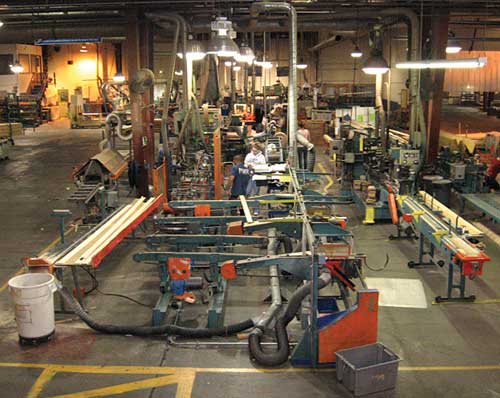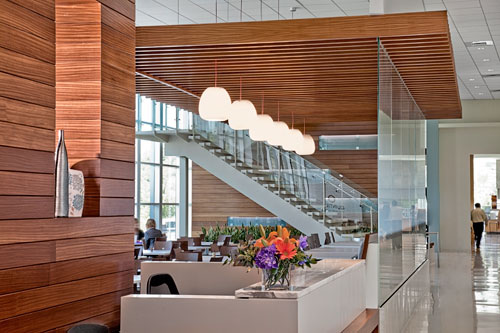Specifying Real Wood Veneer: Versatile, Economical, Sustainable
Adhesives
To insure long term durability and adhesion the best veneer profile wrapped products are bonded with a polyurethane reactive moisture-curing hot melt adhesive (PUR).
Recognizing VOC emissions and industry concerns regarding the quality of adhesion, PURs contain no solvents, offering "green" strength and superior bond performance.
Accepted in many industries as a replacement for mechanical fasteners, moisture curing PURs are applied to a veneer and substrate in a thin adhesive line that sets begins to cross link on the production line, and becomes rigid and inert within 72 hours .
Formaldehyde-free emulsion polymer isocynates (known in the industry as EPIs) exterior adhesives are used in flat lamination. These adhesives cure through pressure and time in the appropriate production press.
 |
Substrate is profile wrapped with veneer on the cell, sanded and goes straight into a carton for shipment. Photo courtesy of Contact Industries |
Veneer Wrapping: From Design to the Production Process
Designers envision mouldings and millwork items in their projects from a number of perspectives, including, but not limited to:
- Finished profiles that represent the design intent.
- Appropriate species and protective top coat finishes.
- Appearance and/or aesthetic needs complementary to other products on the site
- Fit, form and function needs.
- Balanced integration with other materials on the site, including windows, doors, flooring, ceilings, tile, wall coverings, fire-related requirements, etc.
To assure the wisest use of the lumber resource, designers should consider specifying the application and the specification of profile wrapped or flat laminated products on project plan documents.
Responding to these designers' project plans and requirements, manufacturers will then appropriately identify the size and location of the component, and suggest the appropriate pertinent substrate and veneer material for the product size, application and location.
The manufacturer will translate the profile of the component and/or trim designed by the architectural professional into a shop floor manufacturing plant CAD approval drawing.
Upon review and approval, an order is placed, and the manufacturing process begins. The substrate is molded to the pattern of choice, and wrapped in the desired veneer.
Prepping the Veneer. A good profile wrapping process begins with premium veneers that are climate controlled to prevent cracking and are processed from a random width and length flitch stock to assure the most efficient and prudent use of the resource.
This process also allows minor lumber defects to be cut out so that a clear specified product will result, preserving the resource and saving time during installation.
For optimum results, the veneer must be properly prepared in a multi-step process that includes the following:
- The appropriate clear lumber slicing blank is selected and inserted into a water-filled autoclave; a "vacuum" is drawn and water introduced into, and allowed to penetrate all the lumber's cells.
- The "soaked" slicing blank is introduced to the horizontal veneer slicer.
- After the large draw knife slices the veneer from the blank to the appropriate thickness, the veneer is introduced to a dryer where moisture is dropped gently to nine percent.
- The veneer is finger-jointed together into lineal rolls for fleece backing and sanding.
- The back of the veneer is fleeced in a lineal process with heat, adhesive and pressure. The 25- or 50-gram thickness fleece is a nylon material used to bind together the veneer's fiber, and make it more pliable for profile wrapping, enabling it to be wrapped around curves, without changing its physical appearance. The backer should be the proper weight to allow the product to wrap without cracking.
- The veneer is sent through a four-head sander and sanded with a 180-grit finish to achieve optimum smoothness prior to adherence to the core material.
Fabricating the Core. As noted earlier, the predominant core material - is finger-jointed common grades of pine.
In the rough mill this material is processed, finger-jointed and edge- and/or face- glued into core blanks of appropriate dimensions to mould into the shape desired.
If profiling is needed, these blanks are run through a moulder to fabricate the finished core appearance.
In many cases, the core material may require engineering in order to achieve certain performance characteristics.
These would include, such needs as meeting fire codes, weight reduction or requiring assured strength or dimensional stability.
Typically these decisions are made jointly by the manufacturer and architect or end customer, taking into account the product's use, performance expectations and visual appearance, and then value engineering for the optimum combination of performance, aesthetics, environmental impact, and cost factors.
At the Quintiles Pharmaceuticals headquarters in North Carolina's Raleigh-Durham area, architects modified plans for paneling and beams based on stability and cost considerations. The original design called for solid Afromosia tongue and groove paneling and overhead 2-foot x 10-foot beams. Afromosia is a relatively rare, African hardwood species. Using solid lumber for the paneling would have been feasible, but cost-prohibitive and an unnecessary depletion of the Afromosia resource. The 12-foot and 16-foot beams would have been nearly impossible to find in solid wood and even if they could be located, solid wood would have been subject to dimensional stability issues such as warping and checking.
Instead, architects opted for engineering tongue and groove paneling using a pine substrate and Afromosia veneer. The substrate for the beams was fabricated from LVL to address the dimensional stability issues, then wrapped in a two-pass operation in which each beam was end-capped with veneer to give the appearance of a solid piece. The project exemplifies diverse processes, well-conceived engineering, and wood products dovetailing to provide the appropriate product for the job. The wrapped beam met the requirements of dimensional stability, while being cost effective and resource saving, by replacing the originally intended solid Afromosia beams.
 |
Afromosia veneer over LVL rather than solid lumber was a cost-effective, dimensionally stable, resource-saving choice at the Quintiles Pharmaceuticals headquarters, a LEED Silver building in North Carolina. Photo courtesy of Contact Industries |









